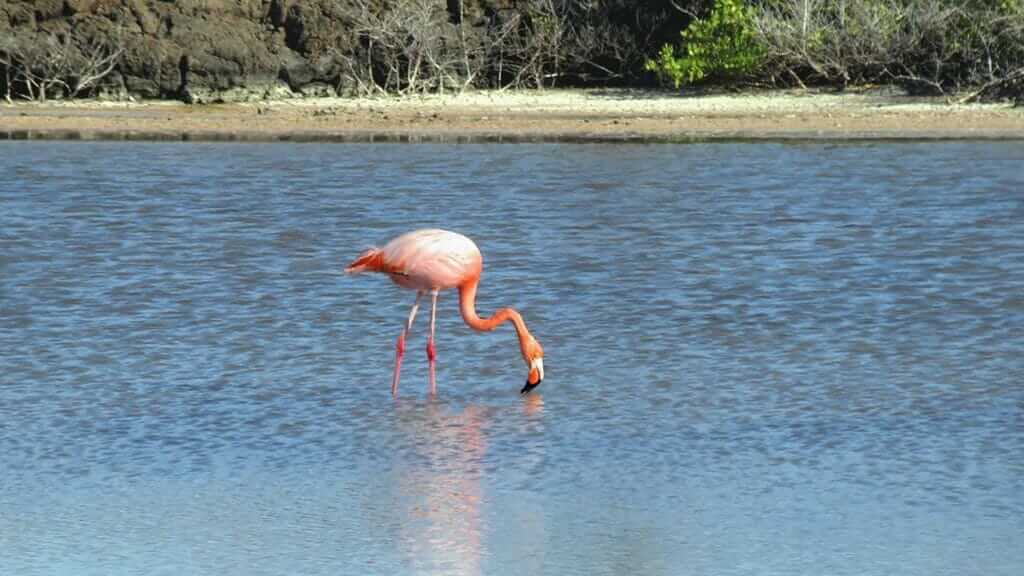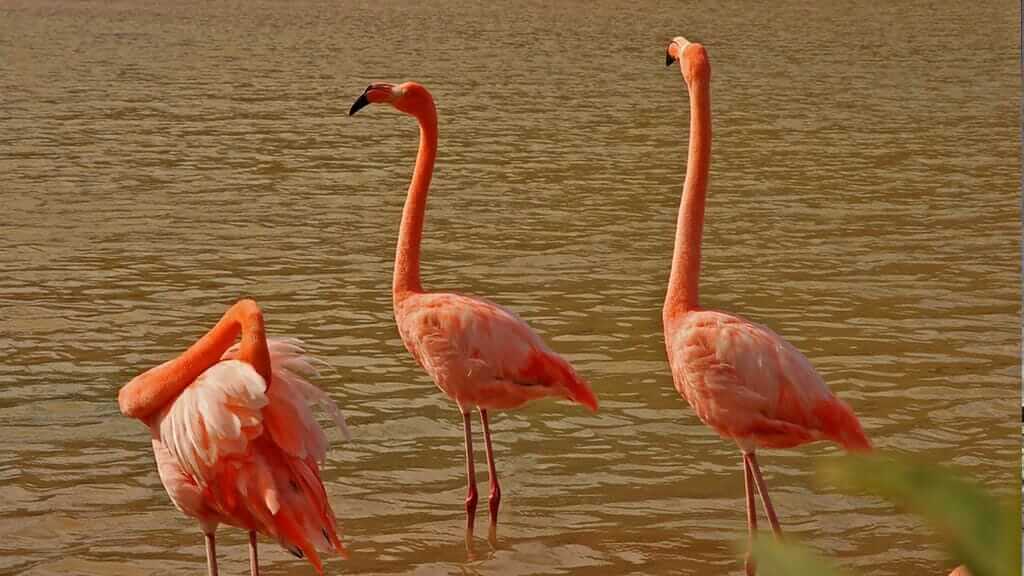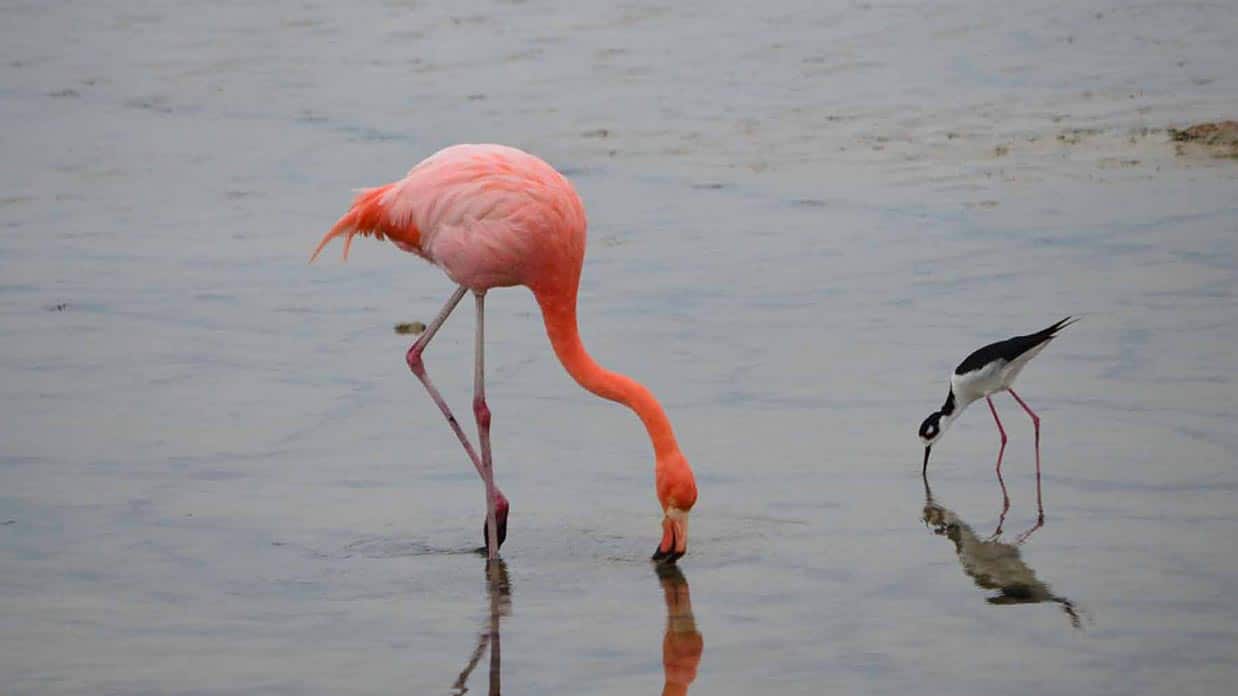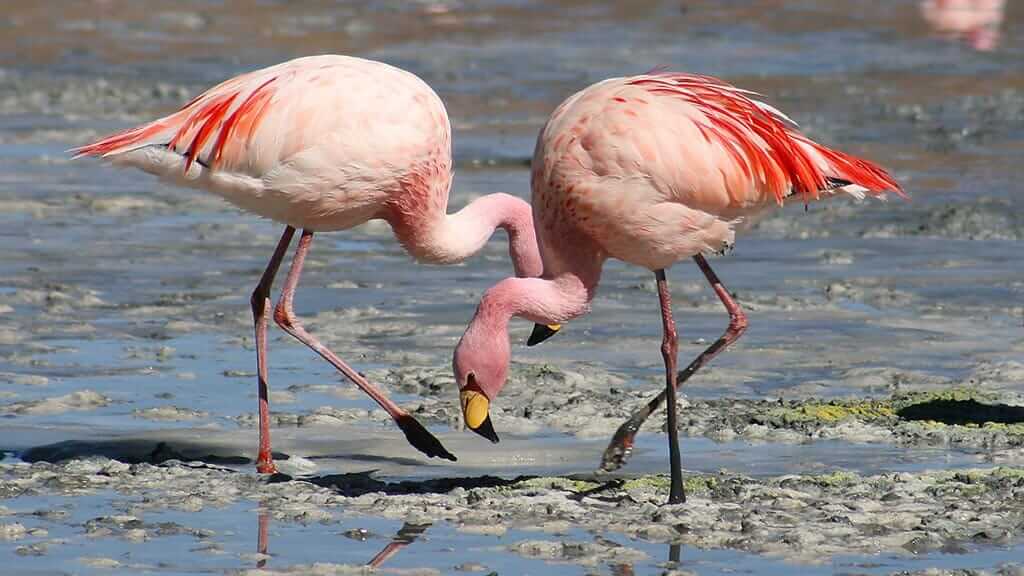GALAPAGOS FLAMINGO
Tourists are often amazed to find flamingos at the Galapagos Islands. And yet here they are, another unexpected surprise for your Galapagos trip. The Galapagos flamingo is one of the most vibrantly pink colored flamingos in the world. They have also adapted to the Galapagos environment in unique ways to be able to live here. Although the Galapagos flamingo population is small in size, there is a good probability to spot them during a Galapagos vacation.
Read on to learn more about the Galapagos flamingo. Where and when can you see them? Plus heaps of other interesting flamingo facts.
Conservation Status: Least Concern
Scientific Name: Phoenicopterus Ruber
How To See A Galapagos Flamingo?
The Galapagos flamingo population is small in size, just a few hundred individuals. But the good news is that their location is quite predictable, as they nest and feed at very specific Galapagos visitor sites.
Galapagos visitors are used to tame species that show no fear around humans. But flamingos are actually quite shy, so you'll need to keep your distance and keep noise to a minimum.
WHERE to see Flamingos in Galapagos?
Galapagos cruise itineraries visit the following sites that are often frequented by flamingos: Rabida island, Punta Cormorant (Floreana), Punta Moreno (Isabela), Las Bachas (Santa Cruz), and Puerto Egas (Santiago).
It's also possible to see flamingos on a Galapagos land tour close to Puerto Villamil town on Isabela island.
WHEN to see them?
Flamingos can be observed year round at Galapagos. To see flamingo courtship dancing and hatchlings, the best time to visit is during nesting season from March to July.
Contact us for a FREE GALAPAGOS TOUR QUOTE, or for more information to plan your Galapagos vacation.
Everything You Need To Know About Galapagos Flamingos
Galapagos Flamingo Appearance
Flamingos are of course one of the easiest birds to recognise on the planet. The bright pink colours, long legs and neck, and their enviously graceful movements, make them unmistakable. Galapagos flamingos are especially impressive for their pink coloring; brighter than flamingos in Africa and other parts of the world.
The Galapagos flamingo is in reality an American (or Caribbean) Flamingo. American flamingos breed at the Galapagos islands and in the Caribbean, but at Galapagos they have developed some genetic differences. Galapagos flamingos are smaller in size and also lay smaller eggs. There is also a lower degree of sexual dimorphism. In fact there is no visible difference between male and female Galapagos flamingos in appearance or color.
Newly hatched Galapagos flamingo chicks are gray/white in color, with downy feathers and red beaks. Their white feathers will begin to turn pink from around 2 years old.
Galapagos Flamingo Habitat
Galapagos Flamingos live and breed in brackish pools and lagoons. Brackish water is a mix of fresh and salt water, but with less salt content than sea water. At Galapagos most brackish pools form in close proximity to the shoreline, often behind a beach. Flamingos like to hang out in shallow water, where they can easily wade for food and nest.
Galapagos Flamingo Behavior
During breeding season Galapagos flamingos perform an elaborate and beautiful mating dance. Flamingo courtship is a group affair. The courting couple perform a synchronised dance, waving their wings, swinging necks and calling to one another. Other flamingo couples also participate in these displays, almost like a group parade. All of this fanfare is certainly worthwhile as Galapagos flamingo couples mate for life. It also makes an amazing spectacle for tourists lucky enough to witness it.
Flamingo nests are made from mud, straw, feathers and rocks. They are build into a tall cone-shaped mound, high enough to protect the eggs and chicks from flooding. The female lays just a single egg, which is incubated by both parents. During this period it is critical that the nest is not disturbed in any way, or the adults will abandon it. This unfortunately makes Galapagos flamingo nests especially vulnerable to introduced species such as pigs, goats, cats or dogs.
Newborn chicks leave the nest almost immediately to join other hatchlings. A small group of adult birds stay on group guard duty throughhout the day. Both flamingo parents produce milk, and nurse their baby chicks for up to two months after birth.
Galapagos Flamingo Diet
Galapagos flamingos eat a varied diet of crustaceans, molluscs, worms, insects, plant material, algae and seeds which they find in brackish lagoons
Unbelievably, flamingos can only eat with their head upside down! To feed they first move their feet about to disturb the water, bringing up material that could be food. Next they walk with head upside-down, scooping up water. Food is filtered out using unique filtering plates in their beaks, straining food from the mud and dirt.
Flamingos owe their bright pink color to their diet. Their food sources contain carotenoid pigment. The more a flamingo consumes, the more intense the shade of pink that they become. The Galapagos island waters are especially rich in nutrients, hence the vibrant pink color of the Galapagos flamingo.
Interesting Galapagos Flamingo Facts
• Flamingos across the world are famous for standing long periods of time on just one leg. While this may look very uncomfortable to humans, it is actually a relaxing position for the Galapagos Flamingo. It's also productive in conserving energy, and reducing cardiac exertion.
• The flamingo has the longest neck and legs in relation to its body size of any bird on the planet.
• As recently as 2015 there have been several rare sightings of Chilean Flamingos at Punta Cormorant on Floreana Island. The Chilean Flamingo is taller and paler than it’s American cousin, but is not usually known to migrate as far afield as the Galapagos islands.
If you enjoyed this post, then why not learn more about Galapagos Bird Species?
In conclusion, the Galapagos Flamingo is a wonderful and unexpected bonus for Galapagos visitors. Although they inhabitat only certain sites at Galapagos, many cruise itineraries do allow the opportunity to see them. Galapagos flamingos are pinker than most others on the planet, as well as genetically unique. It is always a pleasure to observe these beautiful and graceful birds. In particular, the romantic flamingo courtship dance could be a big highlight of your trip!





